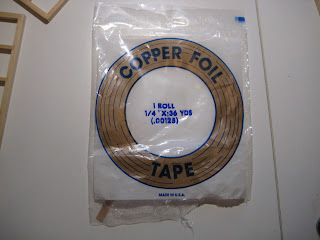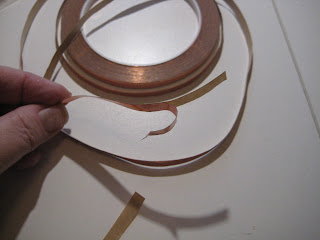I really dislike MDF…I’d rather use Gator board or even the paper-covered foamcore from the Dollar Store than deal with MDF. But since it was the material included, I bit the bullet and forged on.
There are two reasons why I hate MDF. First, it is heavy. Second, it warps…badly. It just sucks up any available moisture if not sealed. I used a coat of white glue to seal the little bit of MDF used on the walls but this was a large piece and I was looking for quick and easy.
I did have some spray sealer by Deft that I’ve used before but I didn’t want to set up the spray booth in the garage. I also happened upon some acrylic matte medium so I decided to see what happened if I brushed that on.
I slathered a light coat of it on both sides and all four edges and let it dry. I dried really quickly and left a slightly rough texture on the board. .. and no warping noted! I thought the “tooth” left from the matte medium might help whatever I used for flooring stick better.
I set the dry fitted Conservatory walls on the base and penciled in the interior. I only wanted the inside done; I was planning something else for the exterior. I was looking through my stash of faux marble tiles and brick stenciling kits when I heard a “tsk….”
“The inside of the Titania’s Conservatory is flagstone…like she saw in old castles on her trip to England as a child. I thought you knew…..”
I turned with a question but Hester had flounced off… I meant to ask about color. I am sure she will advise me in time. Hopefully before I start painting.
So flagstone it is.
I didn’t have any Creative Paperclay and though it is readily available in the US, I didn’t want to make the trip into town to get some. I did have some white DAS air drying clay, however, which I bought at Michaels when my UK friends said Creative PaperClay was nearly impossible to get over there. I’d wanted to see if this stuff was comparable. It certainly is cheaper. It is made in Italy, which was all the information I could get off the package as it was all in languages other than English.
It comes in a 1 kilo (2.2 lb) package. I had the “white” , though I would have called it grey...also comes in terra cotta. It is much heavier and denser than Creative PaperClay but it is not as sticky. It has a more leathery feel.
I tried rolling it out as I do PaperClay but it took more elbow grease.
I think it would have run nicely through the pasta machine which I will do if I use it again. It also doesn’t “seam” as nicely as PaperClay does if you are piecing it…which I had to do for the floor.
Before I applied it, I brushed Elmer’s Glue All inside the pencil line.
A lot of people don’t glue their air dry clay to the substrate but that is how I was taught to do it. I think it helps with the shrinkage, though I didn’t notice much with this product. I rolled it out to 1/8 inch thick on my rolling board.
When it was all in place, I spritzed it lightly with water and covered it with a damp paper towel. As I worked, I folded the towel back, bit by bit. I didn’t notice much premature drying except at the very edges.
I used the same tools as I use for PaperClay. The DAS is a little stiffer so I had to press a little harder but otherwise they all worked fine.
It took a lot longer to totally dry than PaperClay. I can usually paint PaperClay within 12 hours but this is going to be a good 24 hrs before I can do that.
The only cracking was where I had to seam it and only slightly. I filled that in with some lightweight spackle. I don’t yet know if will be apparent when painted.
Like PaperClay, it will shrink away from a cut edge. See where I made the groove a little deeper than I should have…where I didn’t cut through, the edges of the “flagstone” are fine.
I used about ½ of the package for the floor and sealed the rest in aluminum foil and put it in a freezer grade ziplock bag. I can usually “freshen up” PaperClay “ that has gotten dry but I don’t know if that will work with this clay. The fact that it didn’t seam that well using water makes me think that it won’t. But sometime, I’ll try an experiment to see.
Overall, I like this product. Despite it’s odd smell when wet (I can only describe as the smell emitted by working machinery…like ozone..), it is a pretty good substitute for Creative PaperClay. It was much less drying to my hands and required little clean-up as it really didn’t stick to my tools as PaperClay usually does.
But I will still use PaperClay, depending on the project. PaperClay is much lighter when dry.
I should be ready to paint both the “stucco” wall and these flagstones by tonight but unless I get word from “herself”, I’m a little nervous about the color of the flagstone.
I’m sure I’ll get it wrong and never hear the end of it….
Later,
Tabitha






























































